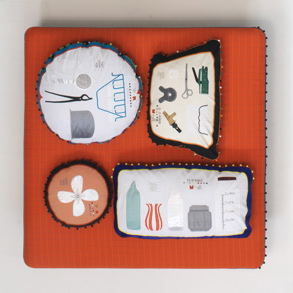
Doshi Levien for Moroso 2
Milan update: here are more images and a detailed description of the new work for Moroso presented by Doshi Levien at the Salone Internazionale del Mobile in Milan last week.
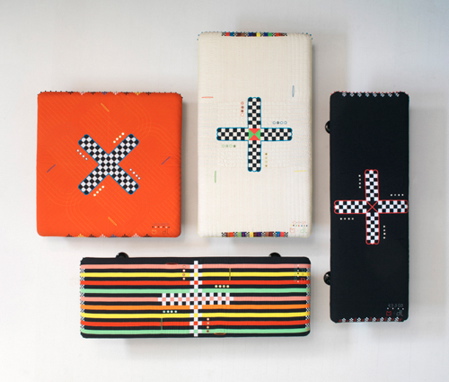
The collection, which draws on traditional Indian furnishings and craft techniques, was one of the highlights of this year's Salone.
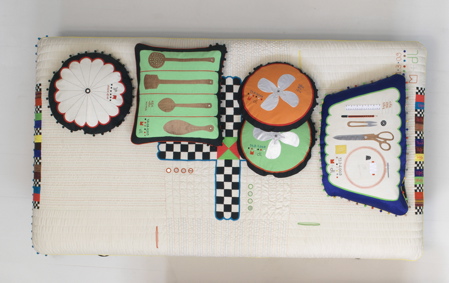
Doshi Levien have sent us this statement about the collection:
--
Doshi Levien intro.
Nipa [Doshi] and Jonathan [Levien] bring together two distinct and complementary approaches to their work. While Jonathan presents a European approach to design, Nipa’s work is strongly influenced by her Indian upbringing. Doshi Levien's work explores the ‘unity of opposites'. They combine the hand made, the unique and the symbolic with the machine made, the industrial and mass manufactured.
Doshi Levien are especially interested in design for and from non-western cultures. As Nipa points out, "Globalisation and international trade is generally viewed as a destroyer of local cultures and the material environment. We like to view globalisation as a way to enhance diversity and disrupt homogeniety; as an opportunity to combine the best of both worlds, now that we have access to other countries and cultures like never before."
"Charpoy" day bed.
A range of four daybeds called 'Charpoy' marry the skilled workmanship of Indian seamsters with Italian expertise in industrial production. 'Charpoy' meaning 4 legs, is derived from the ubiquitous Indian daybed that recurs in several 'Avatars' or manifestations throughout the country; as a stringed bed to sleep on or a daybed for ladies to lounge on and conduct their daily affairs.
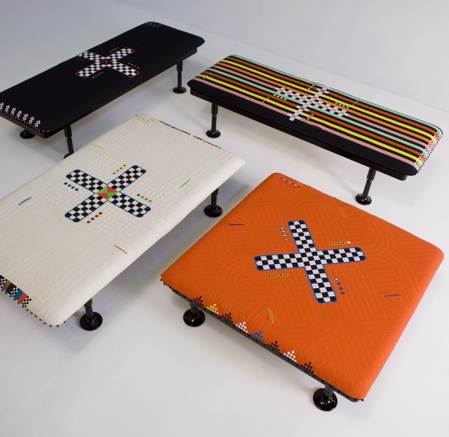
The 'Charpoy' is made using cotton and silk mattresses embroidered with the Ancient Indian dice game of 'Chaupar'. The game itself is like chess and led to the 'Epic' Indian war of 'Mahabharata', when kingdoms and wives were waged as prizes. The great Mughal emperor Akbar was so fond of the game that he had boards laid out in the flag-stoned courtyard at Fatehpur Sikri in Agra, using beautiful girls in colourful saris for the pieces.
The textile techniques used for the 'Charpoy' are local to the western state of Gujarat, known for its embroidery, applique and mirror work. Each piece has a completion date and the names of makers embroidered on it. This detailed hand work is contrasted with lacquered under-frames, CNC machined in Manzano, a region of Italy that specializes in precision wood work.
"Mahabharata." side table.
To accompany the 'Charpoy' range, we designed a Corian side table featuring a miniature painting by Indra Sharma. This painting portrays a scene from the great Indian epic the "Mahabharata" and features the game of Chaupar as seen embroidered into the daybed mattresses.
"Tools of inspiration" pillows.
The idea for 'Tools of Inspiration' presented itself during my collaboration with master textile craftswomen in Ahmedabad, India. The women specialise in patchwork, applique, mirror work and traditional embroidery as they sit cross legged on the floor, using very beautiful utilitarian tools like hand forged scissors, thimbles, marking chalk etc.
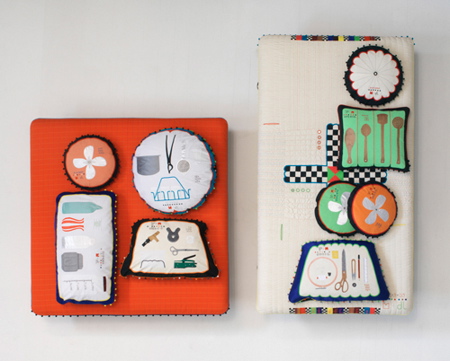
So the idea came, of gettting them to meticulously embroider their own tools on to a pillow. We extended this idea, creating artworks that represent all the simple objects we use everyday and admire in our studio and home. Some of these objects are anonymous design classics from around the world and other objects tell the story of sensual rituals like making Chai, cooking or sewing.
Each pillow has a theme. In all there are nine different designs.
1. Chai: fine white khadi muslin with silk, cotton rubia, metalic silk. Patch worked Utensils include a stainless steel pot, a strainer and glasses with carrier, used to make and serve cups of chai in India.
2. Brass Kitchen tools: khadi tussar silk, cotton rubia, cotton poplin. A collection of Brass spatulas that we rescued from a metal recycling shop in Ahmedabad. They were destined to be turned into wire.
3. Senti cushion: khadi matka silk, cotton rubia, cotton poplin, dutchess satin, metalic silk. A collection of objects that have sentimental value including a pair of shoes from United Nude that took three days to patchwork onto the cushion.
4. Bata Tennis Shoe: fine white khadi muslin, cotton rubia, cotton poplin.
The simple white tennis shoe, worn for sport by all school children in India. its Jonathan's favourite shoe and costs only 2 euros!
5. Rangoli: khadi matka silk, Irish linen, cotton poplin. A pattern drawn with rice flour on the doorstep of homes during festivals like Diwali, to welcome good spirits and the goddess of wealth!
6.Vessels: fine khadi muslin, silk satin, metalic silk, cotton poplin, cotton rubia.
A collection of storage jars from our Kitchen. Including a US milk bottle, an English storage jar, Tord Boontje's bottle for Trans glass, a lota made of recycled red and white plastic.
7. Fan: fine khadi muslin, cotton poplin, metalic silk.
An aluminium computer fan, found on the lower east side in Manhattan.
8. Sewing tools: khadi matka silk, khadi tussar silk, wool, cotton poplin, cotton rubia. Tools used by the seamsters to make the cushions.
9.Stationery: khadi matka silk, khadi tussar silk, wool, cotton poplin, cotton rubia. A collection of stationery and things on my table. An Italian Zenith stapler, a tape dispenser by Alessi and our studio envelopes etc.
The workshop:
The textile workshop is based in Ahmedabad, in the western state of Gujarat, a region in India that is famous for its textile expertise. The workshop was set up by my aunt in 1986 to train, encourage and provide employment to highly skilled textile craftswomen. The Workshop is registered under the Indian Factories act and complies with all government regulations and labour laws etc..
The processes:
We took photographs and scans of a selection of objects and transferred them into accurate CAD line drawings on the computer. Each individual pillow is printed on a thick tracing sheet that is then pierced along the lines. The tracing template is then laid onto the fabrics and a solution is applied that filters through the holes, forming a print on the fabrics after which the the hand applique and embroidery begins.
After the applique work is complete, the pillow is stitched on a sewing machine and the open seams are hand finished. Handmade fabric buttons are sewn by hand on to the pillows.
The fabrics:
The fabrics are sourced mainly from India.The base fabrics for the cushions are Handspun and Handwoven Khadi Silk or fine Khadi Muslin. 'Khadi' translates as a cloth that is woven by hand using only hand spun yarn. The production of these natural yarns, including cotton, silk and wool, is carried out by craftswomen and men in rural communities.
For our designs we also used handloom and mill cottons where we needed colour fastness. To achieve a specific materiality for some of the patch worked objects, we used specialist fabrics from France, Italy and UK like Duchess Satin, Dupion silk and metallic silks.